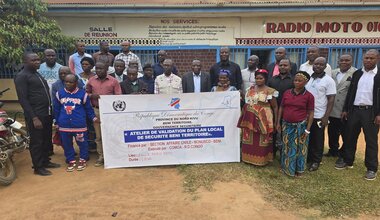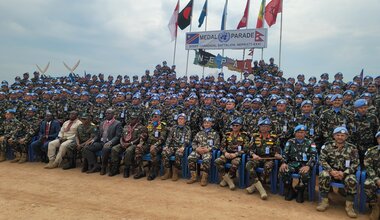Cleaning up UXOs in the D.R. Congo: a Daunting and Tedious Task
Kisangani, 20 August 2011 – The United Nations Mine Action Coordination Centre for the Democratic Republic of Congo (UNMACC-DRC) has, in the past decade, been engaged in identifying areas contaminated by Unexploded Ordnance (UXO) so as to recover and dispose of these devices.
UNMACC indicates that since 2001 when it started its operation, 2 727 areas in all the eleven provinces have been classified as Suspected Hazardous Areas (SHA) or Confirmed Hazardous Areas (CHA), of which 1 127 have been cleared. During the same period, 2 434 persons were affected by these UXOs, among whom 1,036 lost their lives while 1 398 others sustained injuries. These figures illustrate the magnitude of the problem posed by UXOs in the country.
Staff members of the United Nations Stabilization Mission in the Democratic Republic of Congo (MONUSCO) are not safe either. Given the nature of their work, they are constantly in the field, in contact with the local population, and are exposing themselves to the risk of UXOs. For example, a buried grenade was discovered on 11 August at the camp site of MONUSCO's Military Observers in Bafwasende, 262 km east of Kisangani.
The grenade was destroyed a few days later by MECHEM, an international company that is specialized in landmine detection, demining and UXO destruction. Witnesses said the device had probably been left behind by elements of a foreign army that had troops in the region during the 1998 rebellion. If exploded, such a grenade can cause damage within a 100 meter-radius. MECHEM was also alerted to the presence of a second grenade detected near the MONUSCO's main site.
Local authorities in Bafwasende said they were happy with the performance of MECHEM, but added that it could do more. As the demining team leader explained, the aim of demining activities is to mitigate the social, economic and environmental impact of landmines and other types of UXOs. The task of detecting, and destroying unexploded devices takes time, he said. He also said that the area around Bafwasende has for long been the battlefield of successive armies and armed groups who would have left behind a considerable amount of hazardous material.
The case of Bafwasende is, in reality, just the tip of the iceberg in the vast Congolese territory.
André Kitenge, Radio Okapi/ MONUSCO
Photo: Marylene Seguy/MONUSCO
 UN
UN United Nations Peacekeeping
United Nations Peacekeeping










